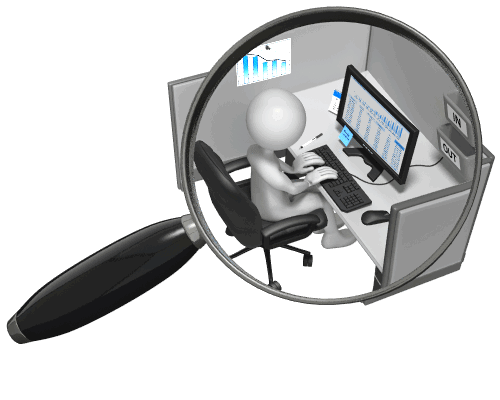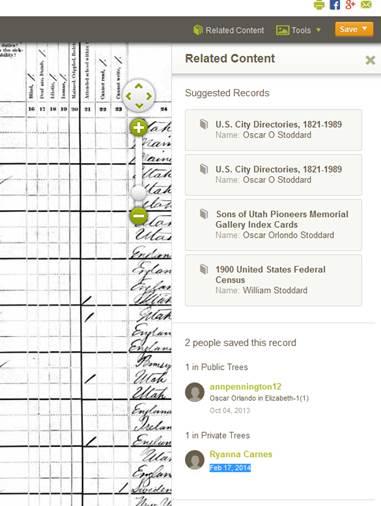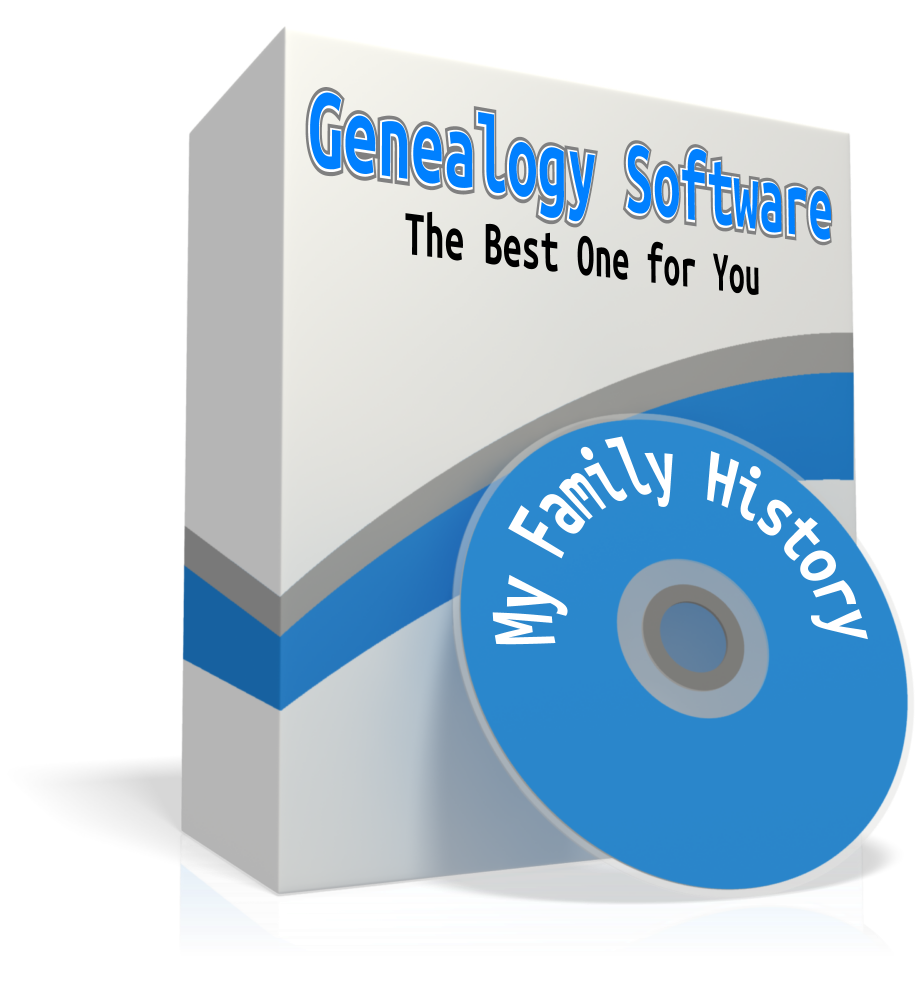by Lisa Cooke | Sep 30, 2014 | 01 What's New, Ancestry, Census, Collaborate
 There are lots of ways to find historical records about your ancestors online. Did you know there are also ways to learn who else has added that record to their trees–or who else is researching the same people you are? Here are two ways:
There are lots of ways to find historical records about your ancestors online. Did you know there are also ways to learn who else has added that record to their trees–or who else is researching the same people you are? Here are two ways:
1. On Ancestry.com, when you are looking at an image of a record, there’s a sidebar to your right called “Related Content.” Click on it. Below other suggested records you will see a list showing anyone who has saved this record to their trees. You’ll see a link to that username and you can contact them. This is what it looks like:  2. On LostCousins.com, you can enter the names of relatives whose names appear on specific censuses. Their database will search for others who are looking for the same people. This is a great resource for people with British Isles roots, as the site originates from there. Here are the censuses they support:
2. On LostCousins.com, you can enter the names of relatives whose names appear on specific censuses. Their database will search for others who are looking for the same people. This is a great resource for people with British Isles roots, as the site originates from there. Here are the censuses they support:
- England and Wales, 1841, 1881, 1911
- Scotland, 1881
- United States, 1880, 1940
- Canada, 1881
- Ireland, 1991.
Basic membership at LostCousins.com is free, but has limited functionality. You can only contact new people during certain windows of time during the year. With a £10 annual subscription, you can make new contacts anytime.  Looking for more ways to find living relatives? Genealogy Gems Premium members can click here to access my full-length video class, Unleash Your Inner Private Eye to Find Living Relatives. Not a member? Click here to join.
Looking for more ways to find living relatives? Genealogy Gems Premium members can click here to access my full-length video class, Unleash Your Inner Private Eye to Find Living Relatives. Not a member? Click here to join.
by Lisa Cooke | Jan 9, 2015 | 01 What's New, Ancestry, Newspaper, Research Skills
 Recently Sue from Elk Grove, Illinois wrote in with a question about what to do when records were lost due to fire (or war, or disasters, etc.):
Recently Sue from Elk Grove, Illinois wrote in with a question about what to do when records were lost due to fire (or war, or disasters, etc.):
“We have been trying to locate information on my great great grandparents Hugh and Mae Sullivan. I have never been able to find marriage or birth records and have realized that it was mainly due to the Great Chicago Fire of 1871. Interestingly, through a directory from 1866, they may have lived only blocks from the origin of the fire. I have them in 1880 with 4 sons, the first of which was born just 10 months following the fire.
“I suspect that they may have lost other children in the tragedy. I am unsure which direction to go to find more of their story and any suggestions would be helpful. Several newspapers are reported to have lists of the missing but I have either been unable to read them or to locate them. Sam Fink’s list [an index of Cook County marriages and deaths] did not provide any information. I suspect that my ancestors were among the very poor immigrants that flooded into Chicago. There were relief societies and I have wondered if records were kept of those who were rehoused.”
Here’s my response to Sue:
 I think you are on the right track with newspapers. Newspapers.com (owned by Ancestry) carries the Chicago Daily from 1871. Here is a screen shot of the List of Missing from Oct. 11, 1871. It might be worth a subscription to Newspapers.com to be able to really comb through all the issues.
I think you are on the right track with newspapers. Newspapers.com (owned by Ancestry) carries the Chicago Daily from 1871. Here is a screen shot of the List of Missing from Oct. 11, 1871. It might be worth a subscription to Newspapers.com to be able to really comb through all the issues.
 Here’s a tip on working with less-than-the best digital images of historical newspapers. You can “invert” the actual image (have it read white-on-black instead of black-on-white), then darken it and add a little more contrast to get the most readable copy possible. This can be done right from the Newpapers.com viewer.
Here’s a tip on working with less-than-the best digital images of historical newspapers. You can “invert” the actual image (have it read white-on-black instead of black-on-white), then darken it and add a little more contrast to get the most readable copy possible. This can be done right from the Newpapers.com viewer.
Also, in Family History podcast episode #37 I discussed a book specifically on Chicago research: Finding Your Chicago Ancestors: A Beginners Guide To Family History In The City Of Chicago by Grace DuMelle. As I recall, it was a very comprehensive book and could give you good leads on where to look.
by Grace DuMelle. As I recall, it was a very comprehensive book and could give you good leads on where to look.

For more tips like these, read my book How to Find Your Family History in Newspapers. Inside you’ll find:
- Step-by-Step Instructions
- Worksheets and Checklists
- Tech Tools You Probably Aren’t Using But Should
- A Massive Amount of Location Specific Websites and a Case Study that Puts It Al Together
by Lisa Cooke | Apr 11, 2015 | 01 What's New, Humor, images, Trees

“STWink Eye” by Source. Licensed under Fair use via Wikipedia – https://lisalouisecooke.com/wp-content/uploads/2015/04/FileSTWink_Eye.jpg.
After the passing of beloved actor Leonard Nimoy last month, MyHeritage.com took a closer look at his ancestry. Through resources on the world tree site Geni.com, MyHeritage discovered that this star of the Star Trek universe is related to another of its stars, though in the show they portray characters from different worlds.
According to a MyHeritage blog post, “Leonard Nimoy is William Shatner’s second cousin once removed’s wife’s first cousin once removed’s husband’s great niece’s husband’s fourth cousin’s ex-husband.”
Okay, so they’re very distantly and circuitously related! But they are, just like many of us. Click on the blog post above to see a chart showing their family relationship.
 Celebrity genealogy aside, do you want to chart your own topsy-turvy family relationships? Click here to find out about relationship calculators and how they help relatives figure out how they are related to each other.
Celebrity genealogy aside, do you want to chart your own topsy-turvy family relationships? Click here to find out about relationship calculators and how they help relatives figure out how they are related to each other.
by Lisa Cooke | Dec 19, 2015 | 01 What's New, Ancestry, Beginner, Technology, Trees
As Family Tree Maker software nears the end of its product lifecycle, many may wonder how far past the “expiration date” they should use it. Here’s my take.
Ancestry.com recently announced that they will stop supporting Family Tree Maker, the popular desktop software that syncs with Ancestry.com trees online. Sales will end on December 31, 2015. Product support and major fixes for current users will end a year later. (Click here for full details.)
This means the clock is ticking for Family Tree Maker users to decide where to put their family trees. Or is it? Can you continue to use software after it’s officially “expired?” For how long? What risks do you take if you do?
Consider the “Best If Used By” dates we see on the food products we buy. There is currently still some life in this product, and will be for a year after they stop selling it. According to Ancestry, during 2016 “all features of the software, including TreeSync™, will continue to work, and Member Services will be available to assist with user questions. We will also address major software bugs that may occur, as well as compatibility updates.” So technically, the “Best if Used By” date is the end of 2016. But then what?
What Happens with Family Tree Maker after 2016?
The software will still function on your computer. But it won’t sync to your Ancestry online tree anymore, and there will be no upgrades to make it compatible with future computer hardware or software. So eventually, you’ll need to transfer everything out of Family Tree Maker software anyway to be able to keep up with evolving technology. That’s what happened to me with my first favorite genealogy software. When it was discontinued, I hung on to it for a long time, and honestly, I had no problem.
Eventually, however, the old software was no longer fully compatible with new operating systems and I had to upgrade. I took a risk in continuing to enter information into an obsolete system–and wouldn’t take it again in retrospect. When it finally did come time to transfer, I was gambling with whether my system had gotten so far behind the times that it would be too difficult or even impossible to transfer everything. (Think how much our data transfer technology has changed in recent years: from floppy disks, CD-ROMs, CDs and DVDs to flash drives and now cloud-based transfers.) And I also ran the risk that there might be license limitations to how many computers my old software could be loaded onto.
Our genealogy software contains thousands of pieces of linked pieces of data: names, dates, relationships, source citation information, digitized photos and documents and more. This is not something we could easily re-create and I for one would not want to have to redo all that research (or even just key it in). Even if GEDCOM files continue as a universal file type for genealogy software, the ability to export every piece of information exactly as you want it in GEDCOMs is not guaranteed. For example, consider that when you download a tree from Ancestry, according to their customer support pages,”Any pictures, charts, books, views, or similar items found in the original file will not be included in the [downloaded] GEDCOM. Vital information, notes, and sources are usually retained after conversion.”
Why continue to load your Family Tree Maker software with data you might not be able to fully retrieve when you want to?
If you’re a Family Tree Maker user, I’m not saying you should panic. You have time to do your homework and carefully consider the best next step for you. You could start using new family history software with a reliable cloud-based back-up service for your computer, so your files are fully protected. You could migrate to another cloud-and-software-sync model over at MyHeritage (their desktop software is free). Click here to read more about those options and see current offers by RootsMagic and MyHeritage.com for Family Tree Maker users.
Bottom line: “Best if Used By” usually indicates that the sooner you finish consuming a product and move on, the healthier and better your experience will be. That is an applicable analogy for Family Tree Maker users. Research your options and move on to another product so your family tree will continue to grow and be healthy!
More Gems for Family Tree Maker Users
Here at Genealogy Gems we care about you and your data. Here are more resources for you:
What Ancestry’s Retirement of Family Tree Maker Software Means for You
Best Genealogy Software: Which You Should Choose and Why
How to Download and Backup Your Ancestry Data
 There are lots of ways to find historical records about your ancestors online. Did you know there are also ways to learn who else has added that record to their trees–or who else is researching the same people you are? Here are two ways:
There are lots of ways to find historical records about your ancestors online. Did you know there are also ways to learn who else has added that record to their trees–or who else is researching the same people you are? Here are two ways: 2. On LostCousins.com, you can enter the names of relatives whose names appear on specific censuses. Their database will search for others who are looking for the same people. This is a great resource for people with British Isles roots, as the site originates from there. Here are the censuses they support:
2. On LostCousins.com, you can enter the names of relatives whose names appear on specific censuses. Their database will search for others who are looking for the same people. This is a great resource for people with British Isles roots, as the site originates from there. Here are the censuses they support: Looking for more ways to find living relatives? Genealogy Gems Premium members can click here to access my full-length video class, Unleash Your Inner Private Eye to Find Living Relatives. Not a member? Click here to join.
Looking for more ways to find living relatives? Genealogy Gems Premium members can click here to access my full-length video class, Unleash Your Inner Private Eye to Find Living Relatives. Not a member? Click here to join.

 I think you are on the right track with newspapers.
I think you are on the right track with newspapers. 




